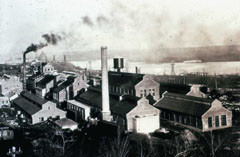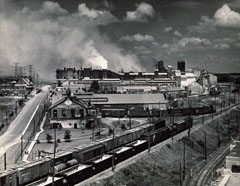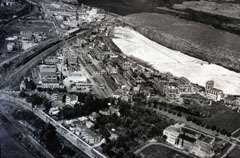Home > History > Shawinigan Water and Power > SW&P's Electro-chemical Complex and Business Strategies
SW&P's Electro-chemical Complex and Business Strategies
SW&P faced financial difficulties as soon as it was founded. There were huge construction costs associated with its hydroelectric plant and other necessary infrastructures. The company focused its efforts on the banks and managed to obtain loans. It also sought other means to increase revenue and elected to invest in a chemical company that wanted to purchase its electricity.
Thus, in 1903, SW&P became involved financially in Shawinigan Carbide. This company located in the city of Shawinigan near the Saint-Maurice River purchased its electricity from SW&P. That same year, it began the production of calcium carbide. The compound is obtained by mixing lime and purified carbon heated in an electric oven at 3 500 degrees Celsius. Under the effect of water, calcium carbide produces a gas known as acetylene. This gas was used primarily to light streets and buildings. In following years, acetylene would be used for welding and become the basis for the production of a wide range of chemical products.
In 1911, SW&P took control of Shawinigan Carbide through the creation of Canada Carbide. Four years later, the company invested new capital in the chemical sector through the newly created Canadian Electro Products. This company specialized in the production of acetone needed for explosives in response to the demand from England, then at war with Germany.
Management at SW&P would establish three other subsidiaries during the First World War: American Electro Products to produce acetic acid, Canadian Electrode to manufacture electrodes for the ovens of Canada Carbide and Shawinigan Electro Metals, specializing in the production of magnesium used by the British Army. In 1927, Canada Carbide and Canadian Electro Products merged to become Shawinigan Chemicals. This company would employ up to 2 000 workers and in the 1950s, was considered among the most important in North America.
SW&P business strategies also included the creation of, and investment in, electrical distribution companies. In 1903, it established St. Maurice Light & Power to provide electricity to the city of Shawinigan and other municipalities in the Mauricie region. Efforts were also made to seek new clients in the Montréal region. In March 1902, SW&P signed a supply contract with Lachine Hydraulic and Land Company to supply the city. Between 1910 and 1920, SW&P extended its range of activities outside the Mauricie region. Through subsidiaries, the company supplied electricity to several localities in the regions of Québec, Lanaudière and Bois-Francs.









